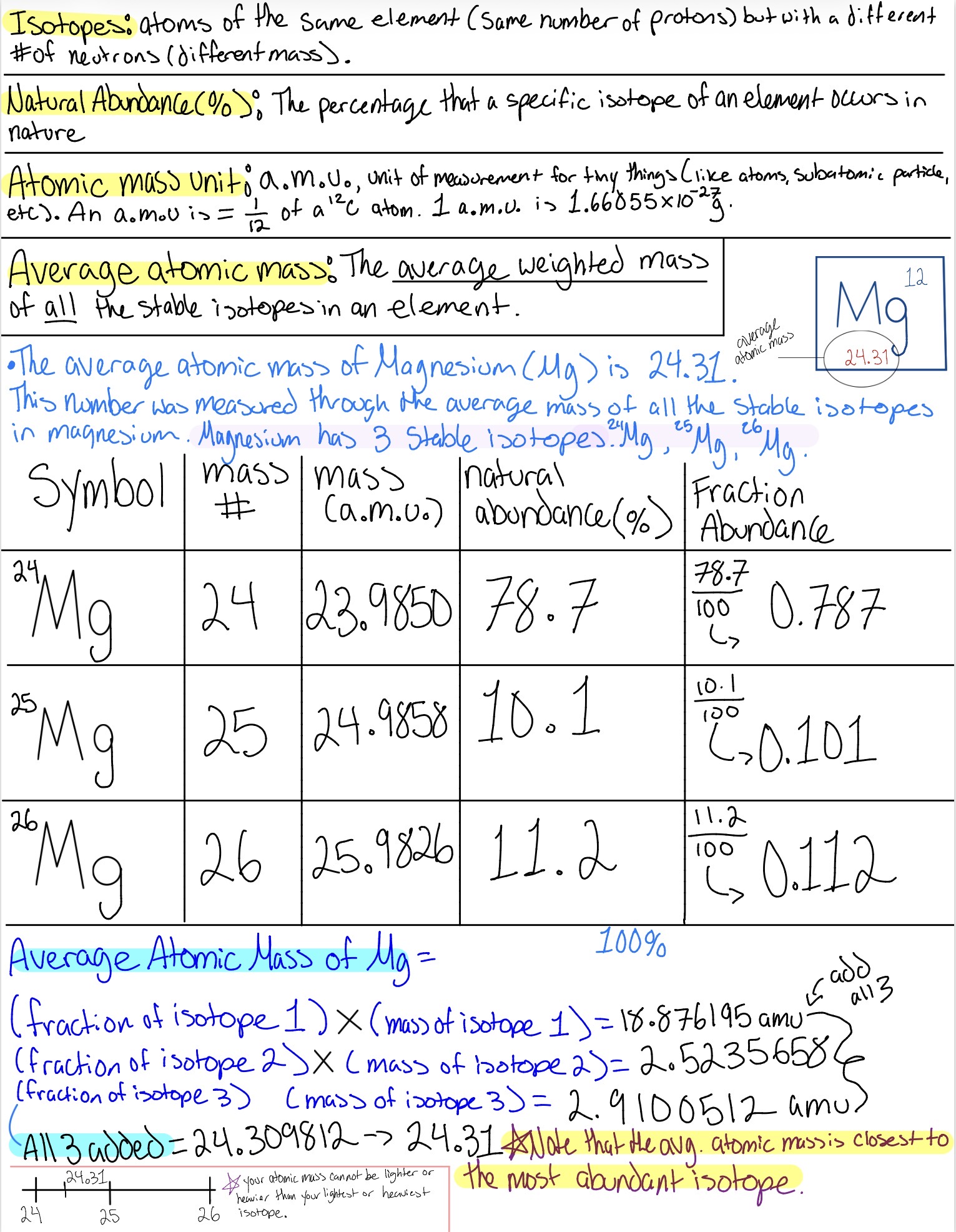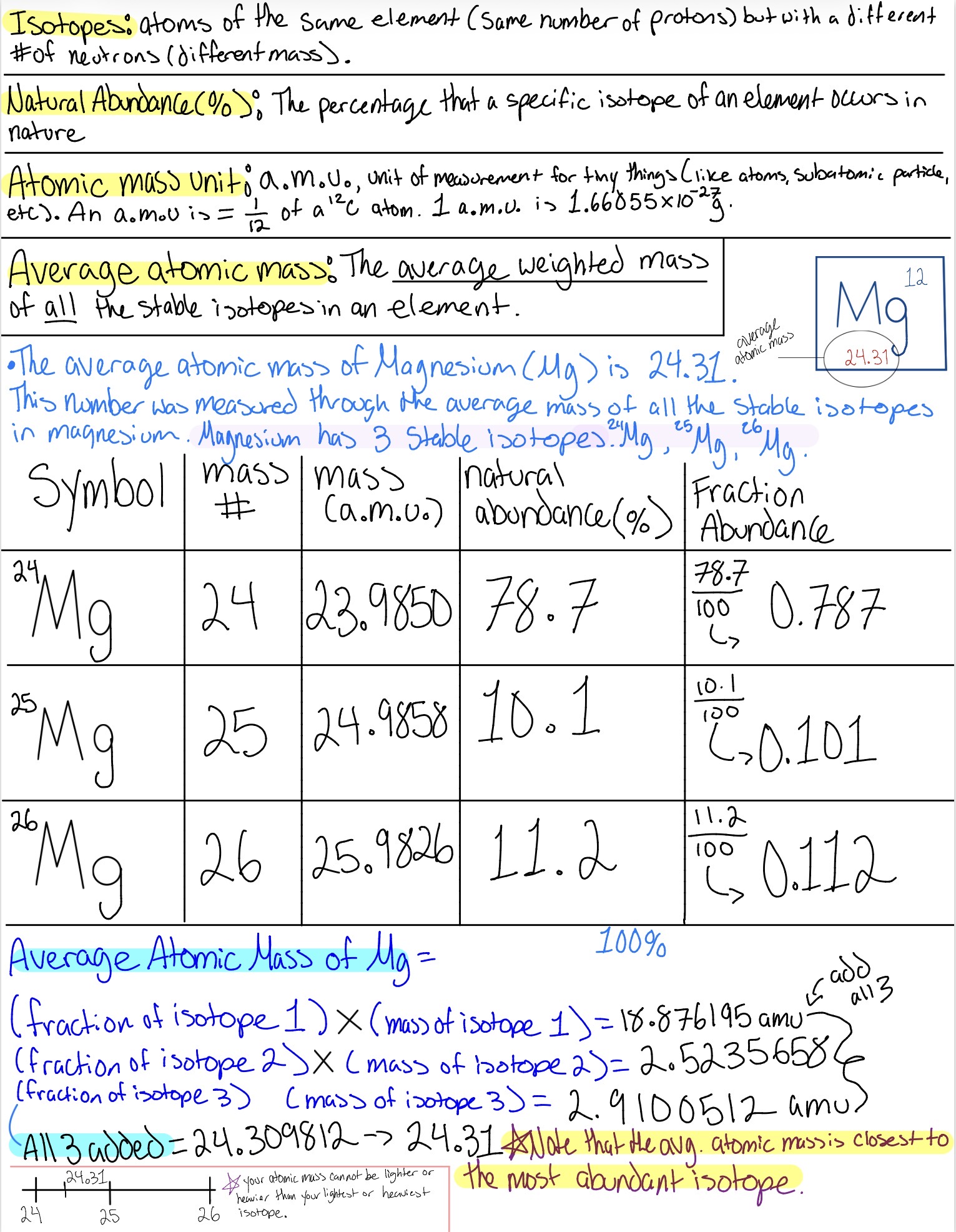Atoms & Subatomic Particles
1/42
There's no tags or description
Looks like no tags are added yet.
Name | Mastery | Learn | Test | Matching | Spaced |
|---|
No study sessions yet.
43 Terms
Atom
The smallest unit of matter that retains the properties of an element. It is composed of a central nucleus containing protons and neutrons (inside the nucleus), surrounded by electrons (outside the nucleus). An atom has a negative and equal positive charge, resulting in it having no charge ((+1)+(-1)=0). This is because an atom has an equal number of protons and electrons.
What is an atoms charge?
0, atoms have no charge. The number of protons equal the number of electrons. (This means that the atomic number (the number of protons in an atoms nucleus) is also the number of electrons in an atom).
Subatomic
Smaller than or occurring within an atom.
Atomic Mass Unit (amu)
Used when describing the properties of tiny objects such as atoms. EX: A proton has a mass of 1.0073 amu.
Electron
A negatively charged (-1), subatomic particle with a mass of 0.00055 amu and is found outside of the nucleus of an atom.
Proton
Positively (+1) charged subatomic particle. Its mass is 1.00727 amu and is located inside of the nucleus. The number of protons inside of an atoms nucleus gives the atom its identity.
Neutron
Has no charge (0). It is the heaviest subatomic particle with a mass of 1.00866 amu and is located inside of the nucleus. (number of neutrons is Atomic Mass (A) - # of protons (or its atomic number, which is the same as the number of protons, Z); N= A - #P).
Nucleus of an Atom
Is positively charged due to the protons (positively charged subatomic particles) inside it. It also holds most of an atoms mass due to it containing protons and neutrons (the heaviest subatomic particles in an atom) inside of it.
All atoms of the same element…
Have the same number of protons.
Isotopes
Atoms of one element with different masses (different number of neutrons) but the same number of protons. They are still chemically identical because they have the same number of protons in the nucleus. (neutrons can change, protons can’t, or else an atoms identity changes).
Atomic Number (Z)
The number of protons in the nucleus of an atom. This is the defining trait of an element. Because atoms have a charge of 0, this means that the number of protons = the number of electrons. Z = P. Atomic number is your number of protons. (Written on the bottom left hand side of a symbol).
Mass Number (A)
The total number of (particles of) protons and neutrons in an atom. The mass number is the number of protons + number of neutrons (#p+ #n = A). (Written on the top left hand side of a symbol). Your mass number (A) is based on the mass of one single isotope.
Ion
Atoms are usually electrically neutral (same number of protons and electrons), when the numbers are NOT equal, the atom is electrically charged and is called an ion. (pay attention to an ions charge).
The Charge of an Atom
Number of protons - the number of electrons (#p - #e). This is because atoms usually have no charge, however, atoms gain charge by gaining or losing electrons (-1). Electrons do all the work. If charge is zero, then #p = #e. (Written on the top right hand side of a symbol).
Anion
Atoms that gain one or more electrons are negatively charged and are called anions.
Cation
Atoms that lose one or more electrons and are positively charged are called cations.
Chemical Symbol
An abbreviation that we use to indicate an element or an atom of an element. EX: Chemical symbol for Sodium is Na. Only the first letter of a symbol is capitalized.
The Atomic Mass of an Atom
is based on the weighted average mass of stable isotopes in an atom/element. These stable isotopes are also accounted for if they are found in nature, and the percentage of how much they affect the atom. Each isotope has its own mass, therefore, your atomic mass (which is = to your average mass) is based on the average mass of all isotopes in an element.
Mass number is
A
A =
#p + #n (this is because protons and neutrons are the heaviest subatomic particles in an atom). So, an atom gets its A (mass number) from the protons + neutrons.
Atomic Number is
Z.
Z =
number of protons. Z is an atoms atomic number, which is the number of protons it contains. The number of protons (its atomic number Z) give an element/atom its identity.
Charge is
Number of protons - number of electrons (#p - #e). This is because only electrons can change, they do all the work. If the protons changed, the entire element/atom would too.
N is
A - P (mass number - protons = neutrons). Remember that an atom/elements atomic mass is protons + neutrons (they hold the highest mass) so to isolate the neutrons, you must subtract the overall atomic mass by protons to get neutrons.
Electrons are
The same number of protons. (With the exception of Ions, which are charged atoms).
If the Charge is 0
your number of protons is equal to your number of electrons. (zero charge = #p=#e).
If there is a Charge
Make sure you look at if it is positively or negatively charged by 1 or 2, and then look at your protons. If it is negatively charged, you have more electrons (electrons are -1) if it is positively charged, you have less electrons than protons.
Mass number & Protons never…
Change. This is an atom/elements identity; like its name.
You will Not find what in the periodic table?
Mass number (A). Mass number only tells you the number of protons and neutrons in one single atom; not in the entire element.
Average mass and Atomic mass
Are equal, they mean the same thing.
Atomic mass and Mass number are different because…
You will not find your mass number in the periodic table. Mass # (A) just tells you how many particles (P&N) are in one singular atom. Your atomic mass (average mass) is based on the average mass of stable isotopes (all of them) in an atom/element.
All atoms in an element are…
Isotopes. Most elements have 2 or more isotopes.
Each isotope has its own…
Mass. (This is taken into account when measuring the average atomic mass of an element. Keep in mind that some isotopes make up an element more than others).
An atom belongs to…
An element. An element can have multiple isotopes (atoms).
Mass # (A) is based on…
The mass of 1 stable isotope.
Atomic Number (Z) =
Protons. When looking at your atomic number, look for the number of protons an element has.
Natural Abundance
The percentage of each specific isotopes occurrence in nature. (Tells us how often this isotope of the element occurs in nature).
Average Atomic Mass
It is the weighted average of the stable isotopes in an element that are abundant in nature and the number under your element symbol in the periodic table. (Remember that some isotopes appear more than others, that is why it is weighted).
Natural Abundance (%)…
Always equals 100% in an element. EX: Magnesium

The isotope that contributes the most to the element is…
Closer to the average atomic mass.
To find the Fractional Abundance…
Divide the natural abundance percentage by 100 (Remember that all the isotopes must equal 100, so each isotope contributes a certain number. To find the fractional abundance, divide the number of its natural abundance by 100 and that is your fractional abundance).
To find the Average Atomic Mass of an Element…
multiply the fractional abundance by the mass (amu) of each isotope, and add all your numbers together in the end. (See image for reference).

The Average Atomic Mass of an element…
cannot be heavier or lighter than your heaviest or lightest isotope.